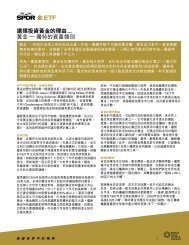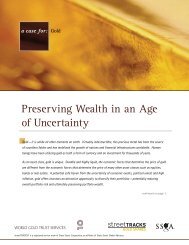Create successful ePaper yourself
Turn your PDF publications into a flip-book with our unique Google optimized e-Paper software.
III: Tail-risk hedging:an international perspectiveExecutive summary<strong>Gold</strong> plays many roles within an investor’s portfolio. It servesas a portfolio diversifier: it tends to have low correlationsto most assets usually held by institutional and individualinvestors. It preserves wealth: gold is typically considered ahedge against inflation, but it also acts as a currency hedge,in particular against the US dollar and other developed-marketcurrencies with which gold correlates negatively. Particularlyimportant to investors, gold also helps to manage risks moreeffectively by protecting against tail-risk events 1 – namely,unpredictable events sometimes considered unlikely whichcause considerable damage to investors’ capital. Notably,these events are likely not only to continue but also to increasetheir frequency as interconnected global economies raise thepossibility of spill-over effects to other markets.The advantages of gold’s role in portfolio risk management have,over the past decade, become better understood in Westernmarkets. In Japan, the role of gold in a portfolio context has onlyrecently gained recognition, yet has advanced substantially inthe past 18 months. This is influenced by such developmentsas the continued weakness of the Japanese economy,deteriorating government finances, unfavourable public andcorporate pension reforms, growing concern over event/tailrisk, change of needs in pension management resulting fromdemographic shifts, adoption of international financial-reportingstandards (IFRSs), and volatile performance of traditional assets.All these factors call for a stronger focus on wealth preservationand performance stability in pension fund management. <strong>Gold</strong> isincreasingly considered by Japanese institutional investors as asolution that meets today’s needs.The country has experienced a prolonged weak economy,described by many as the “lost 20 years of Japan”. Deflationarypressures, declining disposable income, reduced savings rates,and a dim corporate earnings outlook have prevailed. Thegovernment has not yet been able to turn the economy around.The national debt is now more than 200% of GDP, the worstamong OECD countries. 2 The fast-ageing population has putfurther structural strains on the country’s fiscal condition, forcingthe government to cut back benefits owed under the universalpublic pension programme. Facing an uncertain operatingenvironment, corporate pension sponsors have also reducedplan benefits, a significant move in a country known for itsprotective employment culture.As in other markets, we believe gold’s role in Japan extendsbeyond affording protection in extreme circumstances. Inprevious studies, the World <strong>Gold</strong> Council has shown thatincluding gold in a portfolio can reduce the volatility of a portfoliowithout necessarily sacrificing expected returns. However, amore detailed analysis on the effect gold allocations have duringtail-risk events shows that portfolios including gold not onlydeliver better risk-adjusted returns, but that they can also help toreduce extreme losses.This article discusses the benefits of including gold as a tail-riskhedge from an international perspective and compiles researchfindings from previous studies. 3 We show that even modestallocations to gold between 2% and 10%– depending on theassets held by investors and their risk tolerance – can have apositive effect on portfolios. In particular, gold tends to reducenot only portfolio volatility but also losses that may be incurredduring tail-risk events. Looking back at events including BlackMonday, the LTCM crisis, and the recent global financial crisisof 2008 – 2009, our analysis shows that gold mitigated portfoliolosses incurred by investors during almost all tail events underconsideration. For example, investors in the US, Europe, andthe UK who held a 5% allocation to gold, reduced lossesby approximately 5% during eight tail risk events. Similarly,Japanese investors would have saved between 2.3% and 3.6%during nine tail-risk events by adding a 5% allocation to gold in atypical portfolio of foreign and domestic stocks and bonds.1 Tail-risk events get their name from the fact that their occurrence results in extreme and unexpected changes in asset prices (typically negative) that fall inthe ‘tail’ of the return distribution.2 http://stats.oecd.org/3 We concentrate on two previous research notes: <strong>Gold</strong>: hedging against tail risk, October 2010, and The role of gold for Japanese investors during tail-riskevents, November 2012 – originally in Japanese – updating and contextualising their main findings.40_41










